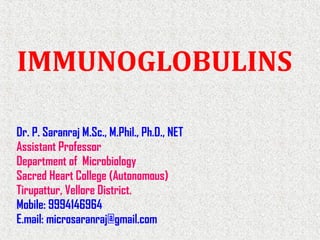Immunoglobulins
•Download as PPT, PDF•
11 likes•2,548 views
Immunoglobulins Structure
Report
Share
Report
Share

Recommended
Recommended
More Related Content
What's hot
What's hot (20)
Immunoglobulin,-Antibody structure, definition, structure, types, functions,

Immunoglobulin,-Antibody structure, definition, structure, types, functions,
Similar to Immunoglobulins
Similar to Immunoglobulins (20)
Lymphatic System and ANTIBODIES (Abs) and complement system

Lymphatic System and ANTIBODIES (Abs) and complement system
IHC fundamentals P#1 w Pretreatment NSH Final Revised 10-24

IHC fundamentals P#1 w Pretreatment NSH Final Revised 10-24
What is an Antibody?Immunoglobulins: Classes and Sub classes

What is an Antibody?Immunoglobulins: Classes and Sub classes
Structure and function of immunoglobulins(antibodies) Likhith K

Structure and function of immunoglobulins(antibodies) Likhith K
More from Saranraj P
More from Saranraj P (20)
Recently uploaded
Recently uploaded (20)
X-rays from a Central “Exhaust Vent” of the Galactic Center Chimney

X-rays from a Central “Exhaust Vent” of the Galactic Center Chimney
Cot curve, melting temperature, unique and repetitive DNA

Cot curve, melting temperature, unique and repetitive DNA
TransientOffsetin14CAftertheCarringtonEventRecordedbyPolarTreeRings

TransientOffsetin14CAftertheCarringtonEventRecordedbyPolarTreeRings
Thyroid Physiology_Dr.E. Muralinath_ Associate Professor

Thyroid Physiology_Dr.E. Muralinath_ Associate Professor
GBSN - Biochemistry (Unit 2) Basic concept of organic chemistry 

GBSN - Biochemistry (Unit 2) Basic concept of organic chemistry
development of diagnostic enzyme assay to detect leuser virus

development of diagnostic enzyme assay to detect leuser virus
Understanding Partial Differential Equations: Types and Solution Methods

Understanding Partial Differential Equations: Types and Solution Methods
Role of AI in seed science Predictive modelling and Beyond.pptx

Role of AI in seed science Predictive modelling and Beyond.pptx
FAIRSpectra - Enabling the FAIRification of Spectroscopy and Spectrometry

FAIRSpectra - Enabling the FAIRification of Spectroscopy and Spectrometry
Use of mutants in understanding seedling development.pptx

Use of mutants in understanding seedling development.pptx
Efficient spin-up of Earth System Models usingsequence acceleration

Efficient spin-up of Earth System Models usingsequence acceleration
The Mariana Trench remarkable geological features on Earth.pptx

The Mariana Trench remarkable geological features on Earth.pptx
FAIRSpectra - Enabling the FAIRification of Analytical Science

FAIRSpectra - Enabling the FAIRification of Analytical Science
Human & Veterinary Respiratory Physilogy_DR.E.Muralinath_Associate Professor....

Human & Veterinary Respiratory Physilogy_DR.E.Muralinath_Associate Professor....
Immunoglobulins
- 1. Dr. P. Saranraj M.Sc., M.Phil., Ph.D., NET Assistant Professor Department of Microbiology Sacred Heart College (Autonomous) Tirupattur, Vellore District. Mobile: 9994146964 E.mail: microsaranraj@gmail.com IMMUNOGLOBULINS
- 2. IMMUNOGLOBULINS Antibody, also known as an Immunoglobulin (Ig), is a large, Y-shaped protein (Soluble Glycoprotein) produced mainly by Plasma cells that is used by the immune system to neutralize microbial pathogens. Antibodies are present in the Blood serum,Tissue fluids and Mucosal surfaces of vertebrate animals. Each antibody has at least two identical sites that bind to Antigens.These sites are known as Antigen-binding sites (or) Paratopes. The number of Antigen-binding sites on an antibody is called the Valence of that antibody. For example, most human antibodies have two binding sites; therefore, they arc Bivalent.
- 3. The first use of the term "antibody" occurred in a text by Paul Ehrlich. Gerald Maurice Edelman who shared the 1972 Nobel Prize in Physiology or Medicine for work with Rodney Robert Porter on the immune system. Edelman's Nobel Prize-winning research concerned discovery of the structure of Antibody molecules. The first evidence that antibodies were contained in particular serum protein fractions came from a classic experiment by A.Tiselius and E.A. Kabat in 1939. Immunoglobulins constitute 20 to 25 % of total serum protein.
- 4. STRUCTURE OF IMMUNOGLOBULINS Gerald Maurice Edelman shared the 1972 Nobel Prize with Rodney Robert Porter for the discovery of the structure of Antibody molecules. A bivalent (arranged in pairs) antibody has the simplest molecular structure, it is called a Monomer. Heavy and Light Chains A typical antibody monomer has 4 protein chains: 2 identical Light chains and 2 identical Heavy chains. Each Light chain polypeptide usually consists of about 220 amino acids and has a mass of approximately 25,000 Da. Each Heavy chain consists of about 440 amino acids and has a mass of about 50,000 to 70,000 Da.
- 5. Disulfide Bonds The chains (Light and Heavy chains) are joined by Disulfide links and other bonds to form aY-shaped molecule. TheY-shaped molecule is flexible and can assume a T shape. Variable (V) and Constant Regions (C) Both Light and Heavy chains contain two different regions. They are (i)Variable region and (ii) Constant region. The two sections located at the ends of the “Y” arms are calledVariable (V) regions. The Variable region is present in both Light chain (VL) (110 Amino acids) and the Heavy chain (VH) (110Amino acids). The Variable regions folded together and forms the Antigen binding site (Paratope).
- 6. The stem of the antibody monomer and the lower parts of the arms of the “Y” are called the Constant regions (C). The Constant region is present in both Light chain (CL) (110 Amino acids) and the Heavy chain (CH) (330 - 440 Amino acids). Five major types of C regions There arc, which account for the five major classes of Immunoglobulins. Hinge region The four chains are arranged in the form of a flexible “Y” with a Hinge region. The Hinge region allows the antibody molecule to be more flexible, adjusting to the different spatial arrangements of Epitopes orAntigenic determinants.
- 7. Fab region The top of the Y consists of two Antigen-binding fragments (Fab) that bind with compatibleAntigens. Fab regions are composed of bothVariable and Constant region (MW 45,000 D). Fc region or Crystallizable Fragments The stem of the “Y” shaped antibody monomer is called the Fc region (MW 50,000 D). Fc regions are important in Immunological reactions. Fc regions are composed of only Constant region. Fc region interacts with cell surface receptors called Fc receptors and some proteins of the complement system. This property allows antibodies to activate the immune system.
